Whitney: Non-art friends sometimes ask if I can take them to openings to meet people, which I thought was weird, until I stopped going to art events for a year and realized there aren’t a lot of scenarios in this city where you’re allowed to just stand in a room and mingle for free. Have art openings replaced stuff to do in New York? This occurred to me when we were hanging out in a room full of parakeets, a ball pit, and a simulated sensual massage parlor last night. I bring this up because I was totally excited about doing all of those things, but mostly not for art reasons.
Michael: Ha! I didn’t even think of that. Like a high-concept “cat cafe”. Mostly, I was impressed with the level of production value at all the openings last night. It seemed like every gallery in the Lower East Side was competing to be the most theatrical and over-the-top for our first week of the season. Even works on paper were displayed as a total environment. Maybe the art world is taking a very big-budget cue from Fashion Week. Everything has to be an immersive experience: flood your basement! Monochrome your gallery! Build an actual playground for your audience!
Whitney: It’s definitely back-to-school carnival week. And people were lined up down to block for the attractions. I even saw singles sitting in a Baldessari ball pit, gazing hopefully at the girls coming in the gallery door.
Salon de Mass-age
Shin Gallery Project Space
66 Orchard Street
Open through Nov 1st
What’s on view: A storefront utterly transformed into a sleazy-looking massage parlor with built-out cubicles, beaded curtains, massage tables, and buckets of cleaning supplies. A new tile floor is covered with a layer of Polaroids of bound women in varying states of undress. Above that, sheets of plexiglass invite the viewer to walk over them.
Whitney: I dunno what the connection is between the installation and the photo above by Vienna Actionist Rudolf Schwarzkogler; it was supposed to be a split show, but I don’t see Schwarzkogler’s work here anywhere aside from a mention in the press release that the parlor serves imaginary “Schwarzkogler clients.” (Michael, did you see any?)
It’s basically a faux massage parlor decorated with bondage photos by prolific Japanese artist Nobuyoshi Araki (Polaroids on the linoleum flooring and larger prints on the walls). The Schwarzkogler mention feels like it’s trying to cast the massage tables as a much edgier gesture; the above picture suggests that we’re going to see something about dick mutilation. But still, even if there was live sex, I’m not sure I’d be much more phased.
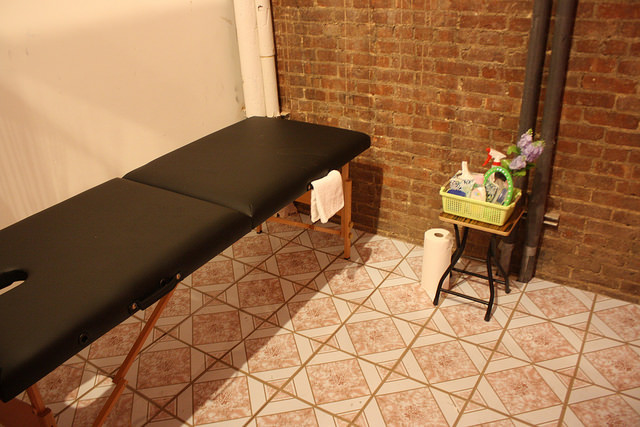 Michael: Yeah, I’m not sure about the Schwarzkogler either. The last time I was in Shin Gallery’s project space, it was an installation that looked like an elaborate film set of a 1980s West German studio and had a few works by Sigmar Polke and Martin Kippenberger staged there. Someone told me that a collector had purchased the work earlier that year and commissioned the installation around the sculptures just to show them, so I’m wondering if there’s a similar situation here with the Schwarzkogler photo? Whatever the story is, I am impressed by how totally and convincingly they transformed the space both times. At first, it took me a minute to process that we were in a pop-up massage parlor in an art gallery and not a pop-up art show in a massage parlor.
Michael: Yeah, I’m not sure about the Schwarzkogler either. The last time I was in Shin Gallery’s project space, it was an installation that looked like an elaborate film set of a 1980s West German studio and had a few works by Sigmar Polke and Martin Kippenberger staged there. Someone told me that a collector had purchased the work earlier that year and commissioned the installation around the sculptures just to show them, so I’m wondering if there’s a similar situation here with the Schwarzkogler photo? Whatever the story is, I am impressed by how totally and convincingly they transformed the space both times. At first, it took me a minute to process that we were in a pop-up massage parlor in an art gallery and not a pop-up art show in a massage parlor.
Whitney: I had the same feeling about a private collection (just because you don’t usually see super famous artists in a fun ground-level experience).
Still it’s a fun little show! The best part for me was picking out the different expressions of the women in the Polaroids on the floor. They were all tied up in Shibari knots and more or less similarly decked out in either kimonos or more American-looking red lipstick and heels, but different personalities emerged through their eyes and angle of their heads. Some women give Araki a kind of death-defying glare, fully aware of the rules they’re trying to smash. Others look prostrate and helpless in a porn star kind of way. Taboo is dead, but it’s still fun to play rebels.
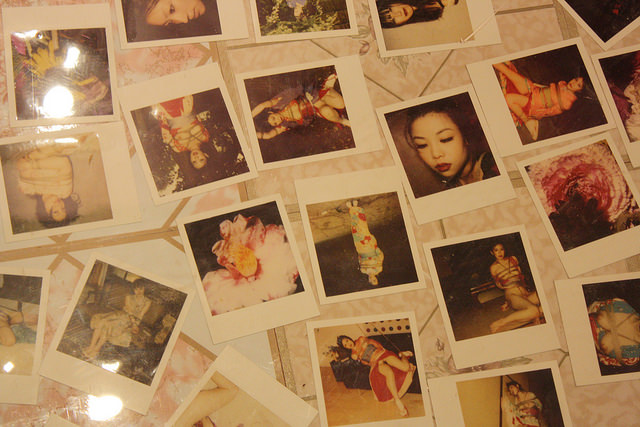 Michael: Yeah the flirting between sexual fantasy and “reality” was really enjoyable—or in this case, the artifice of constructed sexual fantasy and an equally artificial vision of reality. In the same way you found hints of individual personality in the models performing this archetypal bondage tableau, I’m thinking of the “backstage” area behind the massage rooms, where the lingerie is unceremoniously hanging on an unsexy, utilitarian clothesline and there’s a small table set with newspapers and fast food suggesting a casual, quick meal on someone’s break time that was interrupted by a client walking in.
Michael: Yeah the flirting between sexual fantasy and “reality” was really enjoyable—or in this case, the artifice of constructed sexual fantasy and an equally artificial vision of reality. In the same way you found hints of individual personality in the models performing this archetypal bondage tableau, I’m thinking of the “backstage” area behind the massage rooms, where the lingerie is unceremoniously hanging on an unsexy, utilitarian clothesline and there’s a small table set with newspapers and fast food suggesting a casual, quick meal on someone’s break time that was interrupted by a client walking in.
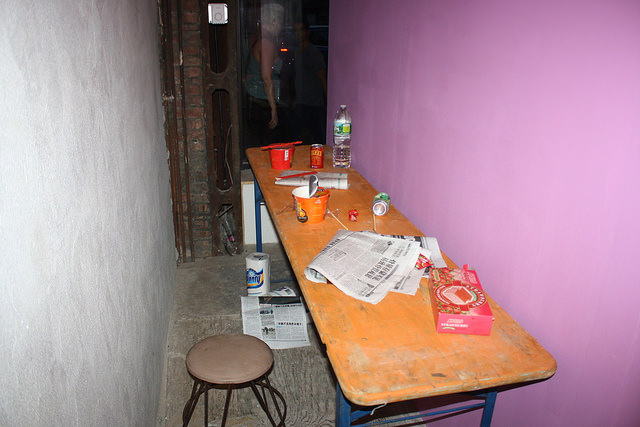
John Baldessari: Come, Sweet Death
Shin Gallery
322 Grand Street
Open through Nov 1st
What’s on view: A noose, a packing crate, a ball pit, and one John Baldessari from 1988.
Michael: This is such a weird show. Baldessari’s 1988 diptych “A Fix’d Inflexible Sorrow” is hanging alone on the wall. Around it, there’s a massive ball pit that takes up half of the gallery floor space and a noose hanging from the ceiling. The odd thing is, the ball pit and the noose aren’t part of the artwork, they’re curatorial staging on the part of gallerist Hong-Gyu Shin. I’m not sure that these interventions make me appreciate the lone Baldessari any more. If anything the imperative to “have fun” seemed distracting and maybe inappropriate to the work? Remember when galleries just gave you wine and cheese? I feel like this is the latest twist in the trend of gallerists curating for the age of the selfie-stick: if the artwork itself isn’t a shiny photo-op, create an Instagram-friendly frame.
That said, I do actually love the Baldessari. In the bottom/right panel, there’s a man slumped backwards in a chair, which he’s tied to. Because his head has been obscured by a circle, it’s unclear if he’s a voyeuristic figure tied to the chair for some fetishistic lapdance or if he’s just suffered some act of violence. Sans the ball pit, the Baldessari piece would actually dialog with some of the more ambiguous bondage pieces by Araki next door in the project space. Perhaps moreso than the Schwarzkogler.
But I’ll be honest, I do love goofy theatricality and decadent staging.
Whitney: I’m just gonna paste the press release here because yeah, this was really weird:
“…the walking space is packed with an array of plastic, playpen balls, integrating an inspired, creative element to our collection. Visitors can wade through the exhibition for a closer viewing of the Baldessari piece to the uplifting melody of “Come, Sweet Death,” whose lyrics offer a straightforward narration of Evangelion’s similar search. Above the plastic balls, knotted ropes hang like nooses from the ceiling as an overarching reminder that our shared “fix’d inflexible sorrow” unavoidably looms overhead, but is ultimately out of our hands.”
Translation: We only have one Baldessari…but we threw in a ball pit! I get the connection, they’re extrapolating themes from the diptychs (the dots and the rope), but it’s like the Baldessari is a jumping off point for a super fun experience. I don’t think you can even call this an art show. It’s definitely not a Baldessari show.
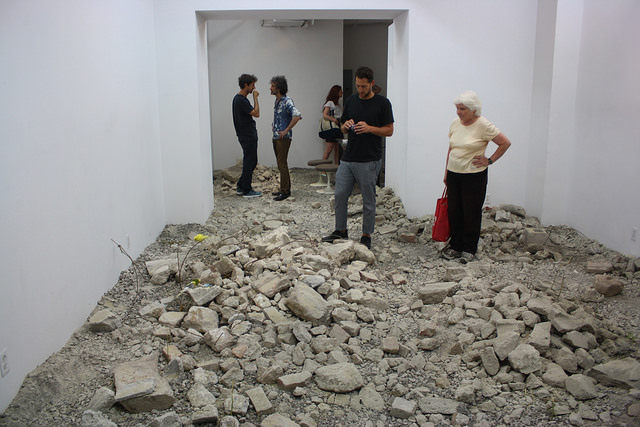
Martin Roth: untitled (debris)
Louis B James
143B Orchard Street
September 9th – October 18th, 2015
What’s on view: The groundfloor of the gallery is filled with rubble: broken cinderblocks, fragments of concrete, and dust with a few sad weeds poking through. Bright-colored parakeets are flying about chirping and eating birdseed out of the debris or perching on the track lighting. The basement is flooded with a few inches of water, some plants, and giant toads in red lighting. All of the live animals were supposedly sourced from a listserve of people who needed to/wanted to give up their pets for whatever reason, and the gallerist assured us that they were being sent to an animal rescue upstate after the exhibition.
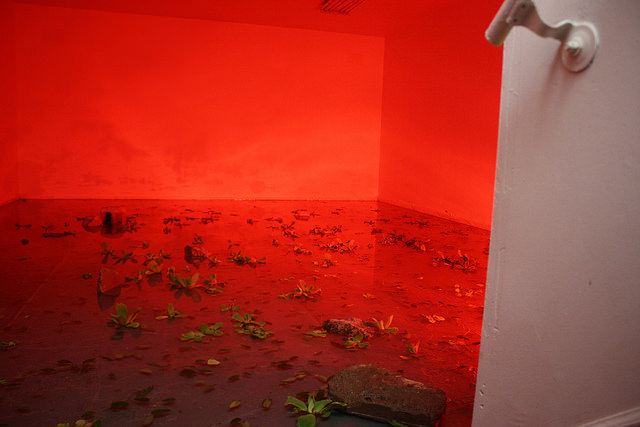
Whitney: Walking into a gallery and hearing “some of the rubble is from the Turkish-Syrian border, some of it is from a New York City construction site, so that really complicates the idea of displacement…”
Michael: Yeah, that made me grimace. I don’t think they actually used the word displacement though, but I remember us talking about that—people displaced by conflict or gentrification (as alluded to by the rubble) and these former pets made “homeless” by whatever circumstances (obviously) beyond their control resulted in them living in an art gallery instead of their owners’ homes or the wild. If that’s the correlation being implied, I do think that’s problematic. I’m not entirely sure though.
Overall I thought the show was beautiful and poetic. It was a really odd sensation, standing in this room full of cute birds and then feeling guilty that we were enjoying a stroll through the ruins of someone’s home transposed to an art gallery. Did you grab one of the newsprint publications with Roth’s photos of the Turkish/Syrian border? They’re really gorgeous too, and the documentation of him loading suitcases with rubble to bring home was one of my favorite moments of the project. It’s such an absurd/poignant image, the idea of wanting to pack up and transport architecture—a place—reduced to trash is so strange on so many levels. Like, something we associate as very permanent and fixed suddenly becoming moveable but paradoxically worthless, and then treating it as something precious.
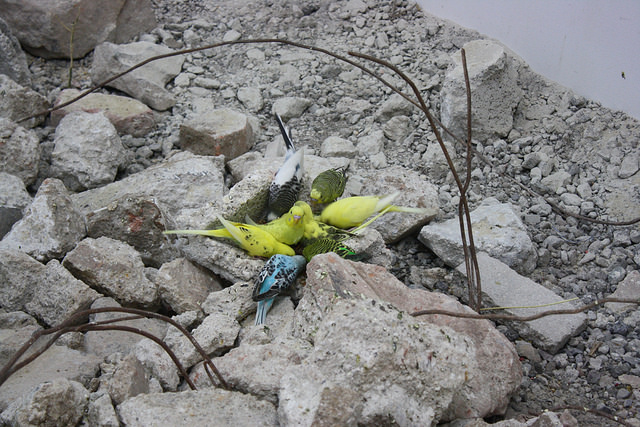
Whitney: I didn’t think much of this at the time aside from a 2+2 conceptual project (Syrian refugees, gentrification– and even those things felt kind of lazily pulling from the social problems bucket) but that’s very insightful. I think I’ll go back without the lines.
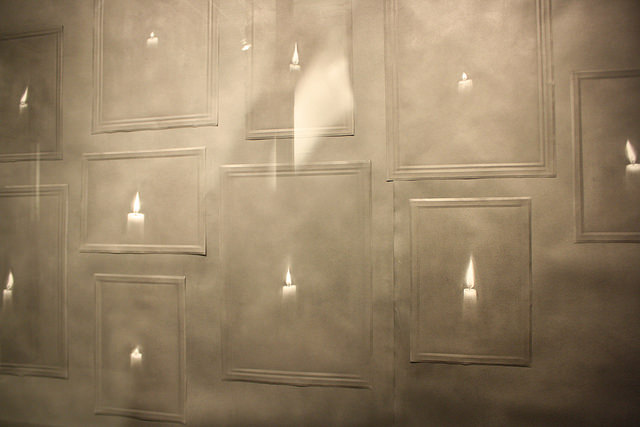
Simon Schubert: Multa Nocte
Foley
59 Orchard St
Through October 18th
What’s on view: Monochromatic floor-to-ceiling folded paper and graphite drawings depicting old-timey domestic spaces, candles, and portraits of Edgar Allen Poe.
Michael: I know you weren’t very impressed with this show, but I liked it. The storefront is filled with really finely-rendered graphite-on-graphite paper drawings of candlesticks in trompe l’oeil “frames”. The gallery’s walls are covered in floor-to-ceiling folded paper intended to evoke the domestic architecture from Edgar Allen Poe stories, including “framed” pictures-within-a-picture and details like wainscoting. Half of the room is covered in graphite-on-black exterior shots of candlelit houses or fires and the other side is white-on-white folded paper interior tableaus of grand staircases, ornate 19th century hallways, and dramatically-lit windows.
If anything, the incredible level of detail in some of the individual works can be drowned out by the sheer volume of things to look at here. Up close, it’s insane how eerie and convincing the empty rooms are. I’m still unsure as to how Schubert was able to convey so much information through creasing paper or capture an almost Vermeer-like quality of light in a monochromatic pallette. I think some of the works used white gesso on white paper for highlights, but I actually couldn’t tell.

Whitney: Yeah I wasn’t too impressed. I do see what you mean by the attention to detail in the white paper pieces, which create highly detailed interiors with no pigmentation, only by creasing and cutting the paper. You can’t not admire the discipline.
Overall, it felt art schooly to me. Charcoal portraits of Poe, candles, and reflective water seemed like convenient set ups to show more of the same, strong drawing skills and command of light and shadow.
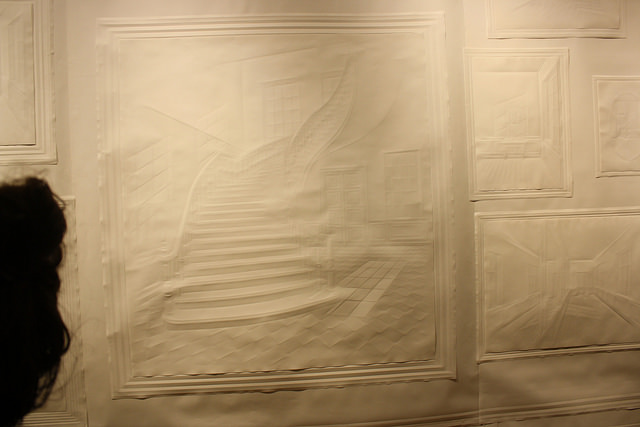

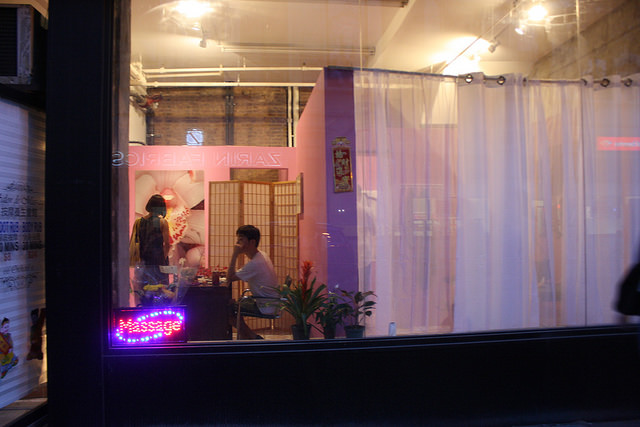



Comments on this entry are closed.
{ 4 trackbacks }